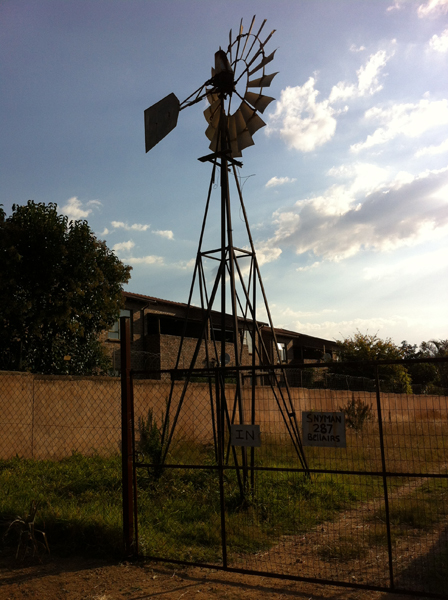
A windpump from forgotten farming days, situated on a property which has withstood the pressures of modern development, in a sea of townhouse complexes. I found it intriguing to view this property in Google Earth - looking at the drive way which is nestled between two developments, wind its way to someone's home in the middle. It is like this home is imprisoned by the developments. I have since found out that "imprisoned" is the incorrect word or assumption! The owners of this property enjoy the seclusion that they get from the surrounding complexes!
The cache is located OUTSIDE the property, and is magnetic. Please respect the entrance to the property and park to the one side, allowing access to any vehicles that may need to come through the gate. PLEASE DO NOT trample on the Aloes! Please be careful when retrieving and replacing the cache as it is quite tricky to get to.
Post publication note: Thanks to Orosman, who had the opportunity of meeting the owners of this property, he found out the following information:
The current owners have been living there since 1969 and the windmill was there long before they even came as it belonged to the Bellairs who owned the land to farm sweet potato. The current owners used to own the land that the complexes are on now, and the reason they sold it was that they thought it would be the best way to hide their house from the street.
This is part of a series of caches near to Windpumps (Windmills) that I've found in or close to the City. A reminder of our farming days of yesteryear.
From South African photographer Chris Myburgh's website:
"The first records found of a windpump in South Africa, is from a painting drawn in 1848. Records were found of windpumps as from 1869 and the first import was in 1874. These were wooden constructions. The first all steel windpump was patented in 1855 in England."
There are a number of types of windpumps manufactured both locally and abroad. Each manufacturer has its own style and branding.
They are fondly referred to as "steel flowers" especially in the Karoo area where they can be found in abundance, providing much needed water to the farms.
Taken from the website: http://www.dwa.gov.za/groundwater/NORADToolkit/7.2%20Introductory%20Guide%20to%20Appropriate%20Solutions%20for%20Water%20and%20Sanitation.pdf
"What is a wind powered pump and how does it work?
Wind powered pumps use the energy generated by wind to lift groundwater to the surface. A rotor is mounted on top of a tower. The action of the wind turns the rotor, which through a gearbox drives a reciprocating shaft. This in turn drives the pump in the borehole.
Wind pump adaptations
The air-lift groundwater pump was developed to provide a low-cost pump for use in informal and rural settlements. This pump system can be operated with tyre pumps. It has a wind pack compressor, capable of storing wind energy as compressed air. This provides supplementary power to the pump. All the working parts of this pump are located above ground, making maintenance easy.
Wind pump requirements
The pump requires sufficient wind speeds for significant lengths of time. The wind pump must therefore be placed where there is a clear sweep of wind. Also, the borehole should provide enough water so that continuous pumping does not result in excessive drawdown. Storage for several days must be provided to cater for calm periods when there is insufficient wind speeds to pump water. Further, someone must be delegated to apply the manual brake to avoid damage during storms.